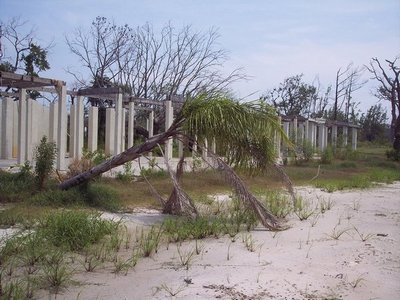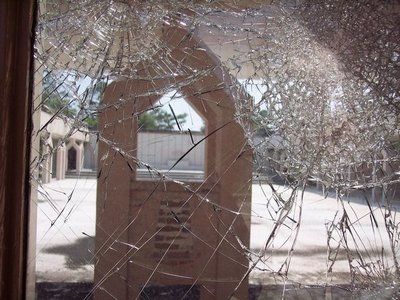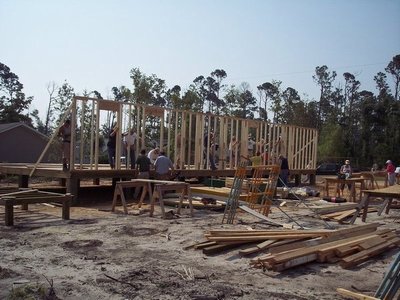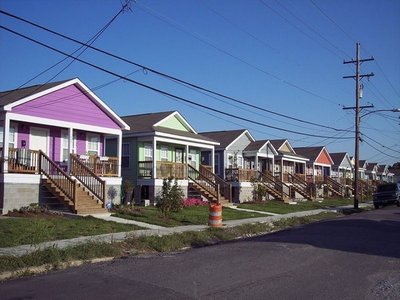May 31, 2007
A long way from recovery: Staffer working on Gulf Coast finds continuing devastation from hurricane
Editor’s Note: News & Information staffer Vince Stricherz traveled to the Gulf Coast last week to work with Habitat for Humanity. This is his first-person account of what he saw there.
If someone tells you the Gulf Coast has recovered from Hurricane Katrina, don’t believe it. It’s not even close.
I spent the week before Memorial Day with a group from Habitat for Humanity of Seattle/South King County building houses in Waveland, Miss., next door to Bay St. Louis — two small towns devastated by Katrina, where the recovery will last many more years.
From New Orleans to Alabama, the damage that is still apparent nearly two years later is heart-rending. With a new hurricane season ready to start tomorrow, it is sobering to realize that if these people were to take another hit this year it could mean the end of centuries-old communities.
There is a lot of hope. Just two weeks ago, the U.S. 90 bridge across the Bay of St. Louis reopened, once again connecting Bay St. Louis and Pass Christian and providing a huge morale boost to people on both sides of the span. There are many people volunteering their time and donating money toward recovery. Other nations are major donors — 10 of the 29 homes Habitat has started or completed in Bay St. Louis and Waveland in the last year were sponsored by the Middle Eastern state of Qatar.
But the truth is that the donations and the number of volunteers are dwindling as more and more people believe that everything on the Gulf Coast has returned to normal and is as it was before. Nothing could be further from the truth. For example, nearly two years after Katrina, there is only one functioning grocery store in this community that used to have several.
Many of the people we met feel as if they have been forgotten. Their houses might have been swept away and they are still living in FEMA trailers. Or they might have suffered serious damage to their homes and are simply living with it. Yet in many cases their jobs are gone, their friends have perhaps died or moved away, and their sense of community has been seriously damaged. In many cases they have been left to pay mortgages on homes that no longer exist.
The psychological toll has been tremendous. We met many people who were angry at government at all levels, while others were furious with insurance companies. Many more just exist, day to day, a haunted look telling a grim story of hopelessness and despair. Churches and social workers say that depression is a very serious problem, even 21 months after Katrina.
Many people have moved away, but the suggestion that the Gulf Coast simply should not be rebuilt because of the hurricane danger bristles to those who remain. It is their home. In most cases they do not want to leave. In many cases they do not have the financial ability to move. They do not suggest that Midwesterners abandon towns because tornadoes are possible, or that people on the West Coast move inland because of the danger of earthquake or tsunami, so they do not understand why some of those people urge that they abandon their homes.
Denise Wilson, a UW associate professor of electrical engineering, talked with our group in Bay St. Louis, where she has been sending students to learn about Katrina’s impact on technology and infrastructure. She told us that many of the health and environmental impacts of Hurricane Betsy in 1965 did not become apparent in the New Orleans area for many years. She suspects that, likewise, the full ramifications of Katrina might not become apparent until years from now.
New Orleans’ Ninth Ward has been a poster child for Katrina’s carnage, and with good reason. The damage is still evident. But even there one can see glimmers of hope. The biggest is the Habitat for Humanity Musicians Village, underwritten by Harry Connick Jr. and Branford Marsalis in the hope of providing new homes for some of the city’s musicians forced to leave after Katrina, as well as for other qualifying Habitat families.
Hope also is apparent on the Mississippi Gulf Coast, largely in the form of churches and other organizations that continue working to bring relief. Lagniappe Presbyterian Church, which formed in Bay St. Louis following Katrina and housed our group, is among organizations working to build houses, encourage the return of businesses and assist in the arduous task of restoring community.
Our group worked on finishing two houses that were started the week before we arrived, then on Friday we did most of the framing for a third house. But there remains a great deal of work to be done. Rebuilding houses and infrastructure is one thing. It will take much more time, effort and compassion to rebuild the devastated lives and livelihoods that make up the Gulf Coast communities.






